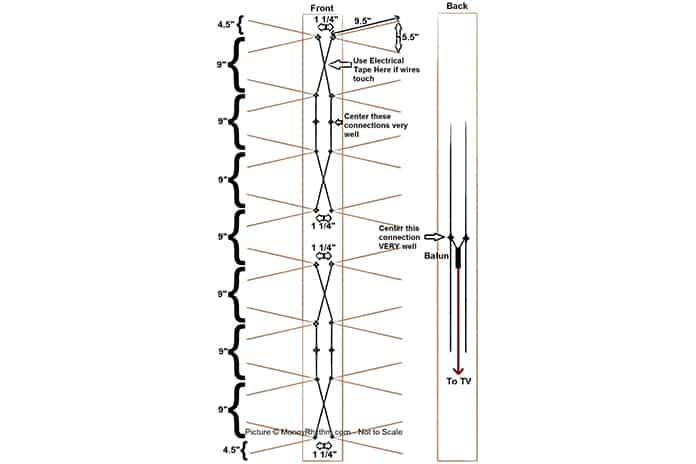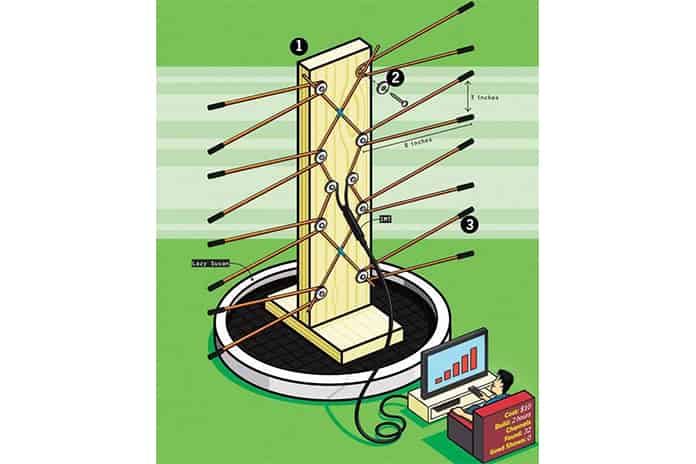An antenna for receiving HDTV digital television effectively captures digital terrestrial television, analog TV for HDTV screens. This is essential if you want your home TV to be able to receive high-quality broadcast channels. However, carriers often charge a high cost of buying and installing HDTV antennas, making them unaffordable for many people. So in this article, TV Mates will walk you through all things you need to know on How To Build A TV Antenna.
Why Do You Need a TV Antenna?
Nowadays, digital terrestrial television service DVB – T2 is extremely developed and widely covered. In the future, it will be most likely to take over the world of cable television. To use this service, the television needs to come with an antenna.
An indoor HDTV antenna is completely different from a traditional outdoor antenna. Its biggest feature is the very compact form, and it’s been designed to be smaller every day. Manufacturers now produce antennas of all kinds of shapes. Users can mount the antenna on the television, put it on the top of the TV, or stick right behind the TV.
A conventional antenna can receive an estimated about 100 different TV channels. It would be best to prepare a good indoor TV antenna, in general, to ensure that the TV can receive high-quality TV channels. Simultaneously, the transmitted signal is also more stable. There is no interference that can annoy you while watching TV. It is not too difficult to have quality entertainment with TV, so installing quality antennas is the first step to get there!
A Step To Step Guide On How To Build A TV Antenna

Step 1: The Preparation Of Tools And Materials
To get started with this product, you will need to prepare the following tools: an electric drill, an electric screwdriver and wire cutter, a ruler, and tape.
HDTV antennas are made of a piece of wood about 0.5m long, aluminum mesh panels, and a balun, commonly known as coaxial port, used to connect to the TV’s port. For aluminum plates, you can get it from any local hardware store. Or, you can just buy the common type of mesh, which is often used as a baking tray in the kitchen. Meanwhile, balun can be found from analog TV antennas or can be purchased at TV repair shops.
You should also prepare some pencils to draw on wood, screws, and copper wire (or aluminum wire hanger) to bend into a V-shape.
Step 2: Make The Antenna Frame
First, you need to prepare the main skeleton for the antenna from the wooden stick and then use a pencil to mark one end about 3cm. From one end to the other, divide it into four equal parts, and draw four parallel lines.
The next step is to cut eight copper wire pieces about 8cm in length and then bend into a V-shape. You can cut it using a hacksaw or wire cutting pliers.
Step 3: Attach Eight Hooks To The Mainframe
You use a drill to drill eight small holes in the marked wood plate, and then screws to screw in the drilled holes. When screwing almost to the wood’s surface, insert the V-hook so that it is held in place by screws.
Keep in mind that using a drill can be very dangerous if you don’t know how to do it, so ask someone with experience to do it for you if possible.
Step 4: Attach The Signal Net
On the other side of the wooden bar, you place the aluminum mesh in proportion and then use a drill to drill screws for fixing the mesh. This aluminum reflects waves into the antenna for better wave quality.
Next, you turn the wooden stick back to the side with the V-hooks and attach the wires connecting the screws. These conductors are absolutely not allowed to touch each other, and the ends of each wire are in the bent position of the V-shape.
Make sure that your lines are insulated. Because when transmitting television signals, the radiated temperature will be quite high and quickly damage the wires. Especially for homemade antennas, the safety criteria are inferior to tested products. However, you should not worry too much about this issue because as long as the wire is insulated, it will be completely safe.
Last but not least, for the balun, you should solder the connection between the wires. Don’t forget to read carefully the instruction manual that comes with it.
Step 5: Install And Receive Pictures From DIY Antennas
In principle, the digital signal will be transmitted in a straight line, so it will be very difficult to encounter difficulties during the reception with a distance of over 100 km. If there are many obstacles around your house, such as hills, high-rise buildings, the reception will become much more difficult.
You need to specify the broadcasting station’s location and the geographical position where you live to get the best TV waves. To do this, you can call your network service provider for information or use location applications on your phone.

Once you have completed a tuned antenna and determined the installation location, test it to see if it works properly. All you need to do is to connect the balun with the cable and then turn on the HDTV and scan it through the channels. If the image quality is good and stable, you are ready to go!
Tips For Making The Best Out Of DIY Antennas
Choose Antenna Cables
The most important but often overlooked thing is the material of the cable.
It would be best if you chose copper cables. These cables have good resistance to interference and a lot more durability than parallel wires.
Regular Maintenance
With homemade antennas, you should check them regularly to ensure the best working condition. Overheating is a big problem for electronics in general, and antennas are no exception. If you notice anything out of the ordinary, you should disconnect the power supply and dismantle it to check immediately.
In Conclusion
A homemade antenna not only can help you catch a stable TV signal but also saves you a considerable amount of money. They definitely are the perfect alternative to expensive antennas in the market. Thank you for reading this, and TVmates.co.uk hope you are now equipped with enough information on How to Build a TV Antenna.
Also Read: What Is The Difference Between Cable And Broadcast TV?



